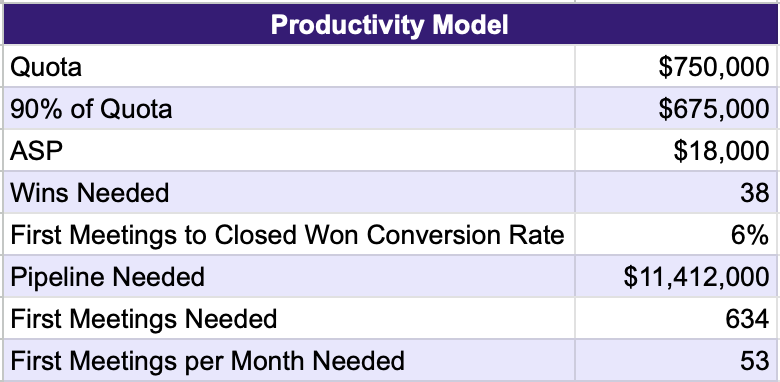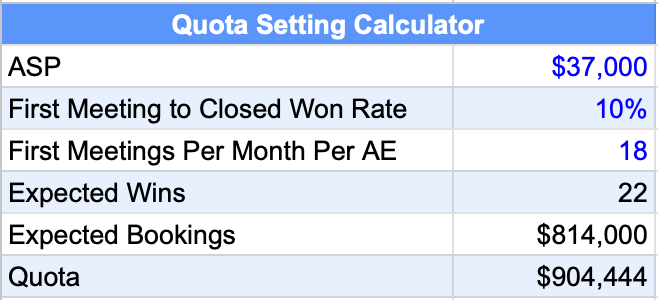Setting AE Quotas at an Early Stage Company
Use data to set the AEs up for success
“I really like this company, but I’m working my butt off and I’m just not making any money and I don’t see a path to hit my quota”
Stan was very frustrated and I could hear it in his voice. I had been doing coaching sessions with him for the past month and was very impressed with him and his ability to take the feedback I had given him and apply it to his opportunities. But I could tell something was off during this session so I just asked him what’s up. He had just gotten his commission check from last quarter and while He knew he didn’t hit his quota. It was frustrating for him to see how far off he was from what he was hoping to earn.
I was working with a company on coaching their AE and so I didn’t know what their quotas were or how they were calculate. I knew that their wins were on the smaller side, around $18,000. I asked him what his quota was and he said $750,000. I did the quick math in my head and realized that he needed to close 30 new customers over the entire year to hit his quota.
And well, I didn’t know how many first meetings he had each month or the conversion rate of those meetings to wins, I had a pretty good suspicion that his quota was unattainable.
Setting Quota isn’t the Same as Building a Compensation Plan
While quotas are the key part of a compensation plan, they aren’t interchangeable. Quotas are just a number - the primary numbers that the Sales team is measured and paid on. Quota is just one part of the commission plans, which include a lot of different elements, most of which you’ll have to determine based on how you want your GTM organization structured.
Are AEs paid on renewals or is that another team like Customer Success? If AEs are paid on renewals, what’s the rate for that?
How are multiple years deal handled?
Who is responsible for expansions?
The Golden 3 KPIs
There are three KPI’s that I’m always looking for when talking to an early stage company that gives me a really good picture of where they are:
ASP or Average Deal Size
First Meeting to Closed Won Conversion Rate
First Meetings per Month
There is a fourth one that is pretty important which is time it takes to close a deal, but I can usually estimate what that is depending on the ASP. By no means is this going to tell you everything about an early-stage business (churn rate, expansion rate are just a few of the other critical KPI‘s), but it gives you a pretty good sense of how a sales team is doing.
These metrics are really all that you need when setting AE quota.
Some Simple Math
After Stan shared his frustrations with me, I went back to John the CEO, and asked him for those three numbers. With these numbers, I could determine what a fair quota was. [Note that I’m using an AE Productivity model, which is essentially the inverse of the quota setting model. In this case, I’m taking quota and working back to see how many meetings/wins are needed and in the AE Quota Setting model, I take first meetings per month to calculate quota.]
While I expected a mismatch, I was shocked how unattainable Stan’s quota was. He was getting just under 20 first meetings a month. But the quick model I had built out showed that he needed 53 meetings per month. That was almost three per work day. And this is a sale that often took several meetings and a small POC to get a win. There just weren’t enough hours in the day or enough meetings to justify his quota.
Justification but Not Good Reasons
I went back to John and told him that there was no way that his AEs could hit these quotas and that they were set up for failure. His justification included these 3 reasons:
He was told that quota should be a multiple of OTE to justify the cost and that’s how he set it.
He wanted Stan to generate more meetings and this was a way to do that
A good AE should convert a higher percentage of opportunities to wins
Let’s address each of those items because on the surface, they seem reasonable:
Using OTE to Calculate Quota
Best practices for AE compensation says that quota should be 5x OTE, although most start-ups are around 4x OTE. Stan, and the other AEs, had quota around 4x so it made sense from that perspective.
However, there are also benchmarks that show what quota should be based on the ASP and for <$25K, it’s usually around $600K. This would indicate that they should have a more junior AE with a lower OTE selling this product.
I brought this up to John and he said the product was too complex for such a junior seller and he needed to hire AEs with Stan’s experience. I said that might mean you have GTM fit issue. While you can sell your product at that price point, it doesn’t justify the cost to do so. Ultimately, the ASP needs to be higher or it needs to be more self-service sales (i.e.: PLG).
Generate More Meetings
John’s next point was that Stan should generate more meetings himself. A fair point - there was certainly room for improvement here - but Stan was already generating a meeting or two per week and he would have to generate almost 4x that. Generating 30 meetings per month was just not realistic with the work he had to do selling the product. They also hadn’t built out a prospecting playbook that someone working full-time could generate that many meetings.
This ultimately led us to a discussion on what the breakdown should be on where first meetings come from and how much should be inbound vs. outbound. This ultimately was one of the biggest takeaways as they needed a much stronger inbound channel for the product they were selling.
Convert a Higher Number to Customers
The final issues that John raised was that Stan should convert a higher number to customers. My assessment was that Stan was a good rep and that wasn’t the primary issue. Ultimately, they were getting a lot of first meetings from people who didn’t match their ICP, leading to a low conversion rate. We had discussed targeting and qualifying better but the number of meetings was already too low so that made it difficult to implement for John.
Setting a Realistic Quota
I think the ultimate question in this case was whether John’s company was ready to hire AEs or not. They didn’t have the playbook, whether it’s for prospecting, finding their ICP, or executing against that, to cost-effectively scale up the Sales team.
There are cases where you want to hire an AE to start figuring out some of these things and that’s a perfectly reasonable approach - you just can’t set their quota like this is all figured out already. You have to realize it’s an investment until these things have been figured out. If the risk is all on the AE side, you’re not going to keep good reps for long.
Setting Quotas
Setting AE quota should be one of the easier things that you do. In the Quota Setting model, you can fill in three numbers and it will calculate the quota. Let’s check out what Stan’s quota should have been:
ASP: $37,000 for their average new logo deal
First Meetings to Closed Won Rate: They convert 1 out of every 10 first meetings into a customer so 10%
First Meetings Per Month Per AE: While it varies from month to month, they are getting 18 meetings per month per AE
Note that the expected bookings is 90% of quota, which is a common way to give the AEs a little bit of a stretch goal - to make sure that those above average are the ones hitting their quota.
I’m OK if the numbers you use are slightly above your baseline because you plan to improve over the year. For example, the number of meetings per month might increase 5% each month as inbound ramp up. But assuming something like a 2X improvement and one of these metrics on just a hope of prayer is not going to end well. This is where I see most organizations make the mistake. They might feel that the AEs need to generate twice as many meetings but is that on the AE or something for the whole company to figure out.




